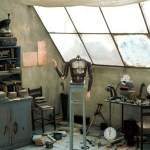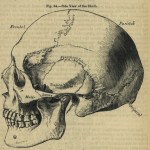Museum Lust
Under glass, a bare forest of pins
held down an army of insects in ragged rows. . .
--"The Expression of Emotion in Man and Insects," by Debora Greger (read the full poem at the Atlantic)
L'Automaton #06, 2010
Paolo Ventura
(zoom view available here)
Artist-photographer Paolo Ventura constructs and photographs miniature, dreamlike scenes. His Winter Stories represent the reminisces of an old circus performer. Above, a scene from the Automaton series captures a mysterious, half-built android. Who is the android's creator? When and where is this happening? Ventura's work is evocative precisely because it is so mysterious. (It turns out that Ventura's backstory for the Automaton series involves a lonely watchmaker in the Jewish ghetto of 1942 Venice - but still, that hardly…
From 1810-11, architect and amateur naturalist George Perry published The Arcana, a lavishly illustrated, serial natural history magazine. Although Perry intended for the serial issues to be assembled by his subscribers into a book, only thirteen complete copies are known to survive today. More than a third of the known copies are in Australia - perhaps fittingly, as Perry was the first to publish an illustration of the koala (above).
Perry's work is not well known; in researching this post, all I could find online were auction listings and occasional references to a recent facsimile…
From the Smithsonian, a short video about using technology to virtually reassemble ancient art from fragments long carried away and dispersed:
Majestic sixth-century Chinese Buddhist sculpture is combined with 3-D imaging technology in this exploration of one of the most important groups of Buddhist devotional sites in early medieval China. Carved into the mountains of northern China, the Buddhist cave temples of Xiangtangshan were the crowning cultural achievement of the Northern Qi dynasty (550-77 CE). Once home to a magnificent array of sculptures--monumental Buddhas, divine attendant…
. . . they could have. Or pretty darn close, at least - they just needed to visit one of the many European cabinets of anatomical curiosities, to see the work of anatomists like Honore Fragonard.
Fragonard's eighteenth-century ecorches were the clear precursors to Gunther von Hagens' "Body Worlds" exhibits: preserved, injected, partially dissected bodies in lifelike, dramatic poses, with ragged strips of muscle draped like primitive clothing over exposed vessels and nerves. The effect is eerie - like a Vesalius illustration sprung to (half-)life:
Man with a Mandible
Several of Fragonard's…
minouette of magpie & whiskeyjack has posted an interesting meditation on the resemblances between Katie Scott's whimsical faux-botanical/biological atlas pages (above), the illustrations of Ernst Haeckel (whose portrait minouette just finished), and the Codex Seraphinianous. It's a harmonious grouping of artistic influences - check it out.
Animated Anatomies, a new show at the Perkins Library at Duke University, explores the tradition of fold-out or pop-up paper anatomical diagrams:
Animated Anatomies explores the visually stunning and technically complex genre of printed texts and illustrations known as anatomical flap books. These publications invite the viewer to participate in virtual autopsies, through the process of unfolding their movable leaves, simulating the act of human dissection. This exhibit traces the flap book genre beginning with early examples from the sixteenth century, to the colorful "golden age" of…
Alienation often accounts for a macabre sense of the marvellous. At the entrance to "Savage Beauty," there is an evening gown conjured entirely from razor-clam shells. Antelope horns sprout from the shoulders of a pony-skin jacket, and vulture skulls serve as epaulettes on a leather dress. There are angel wings made out of balsa wood, and worms encased in a bodice of molded plastic. "I'm inspired by a feather," McQueen said of all the duck, turkey, ostrich, and gull plumage in his clothing--"its graphics, its weightlessness, and its engineering."
--Judith Thurman
"Dressed to Thrill," a…
Through the end of May, UMBC's Albin O Kuhn gallery is hosting a large exhibition of postmortem daguerreotypes, death masks, coffin plates, etc. from the collection of Dr. Stanley Burns.
Medical ephemera always have an emotional valence, because they represent patients who suffered, struggled and eventually lost their physical battles. But this collection of memorials are about the survivors' needs, not the dead, and are thus particularly eerie and wrenching.
From the curator:
Trace the evolution of postmortem photography through 19th-century daguerreotypes and prints from Sleeping Beauty…
Earth Spirit, 2010
Enrique Gomez de Molina
Reader Laura alerted me to this iO9 post I missed on taxidermy artist Enrique Gomez de Molina, whose work would be written off as bad Photoshopping - except it's real sculpture.
The artist says,
The impossibility of my creatures brings me both joy and sadness at the same time. The joy comes from seeing and experiencing the Fantasy of the work but that is coupled with the sadness of the fact that we are destroying all of these beautiful things.
See a video of a sculpture in progress - a rhino covered with peacock feathers and thousands of individual…
Anatomical engraving from Henry Gray's Anatomy, 1858.
A month or so ago, Abrams books reached out to mention that they were releasing a new title, Human Anatomy: A Visual History from the Renaissance to the Digital Age. I said, "don't I already have this book?" It turns out I did - I had the previous, hardback edition which I picked up for $25 or so on Amazon (a deal, I thought at the time). So I knew this book should really be subtitled "vintage eye candy from Vesalius to Schmiedel," because it's a bundle of rich images from anatomical atlases, interspersed with just enough curation to give…
The 2011 Congress of Curious Peoples, featuring, among other guests, Anna Maerker, author of Model Experts: Wax Anatomies and Enlightenment in Florence and Vienna, 1775-1815; Mike Sappol, author of A Traffic of Dead Bodies: Anatomy and Embodied Social Identity in Nineteenth-Century America; Elizabeth Stephens, author of Anatomy as Spectacle: Public Exhibitions of the Body from 1700 to the Present; and John Troyer, author of Technologies of the Human Corpse (forthcoming). Whoa.
Learn more here!
David Clarke, president of the DC chapter of the Guild of Natural Science Illustrators (a great group that I considered joining once, long ago and several careers away), just passed along an invitation to an event next week. The artists who created the work in the Smithsonian's NMNH Hall of Human Origins will be talking about their process, the science behind it, the equipment they use and the working of their studios. While this is the DC GNSI meeting, they are graciously opening it to the public, so if you are in the DC area, consider attending.
More info about the event below the fold.…
Lest any of my faithful readers think they're the only ones whose wonderful linky suggestions I don't seem to get around to posting, my boyfriend sent me this and I didn't post it, and apparently it's on the Daily Dish and 3QD today & he's all like "why didn't you post it sooner? Didn't you get my email??"
Sigh.
So for the record: Brian Dettmer is amazing. He makes these sculptures by carving away - not adding or repositioning - the pages of old illustrated books. And another thing that's really cool: letting the blogosphere (that's me!) disseminate and respond to his work is part of…
I'm too busy to write anything remotely interesting right now, so thanks, NYT & Bay Citizen, for filling the gap with an article about how Eadweard Muybridge. Best known for photo sequences capturing running horses and athletes, Muybridge bridged (ahem) art and science in his work, in addition to having a peculiar name*:
Like the multitudes of misfits who have been flocking to the Bay Area since the Gold Rush in search of a fresh start, Muybridge lived a life of constant artistic reinvention. He changed his name several times (he was born Edward Muggeridge in 1830 and eventually became…
Experiencing late-afternoon unproductivity? Go play with Google Art Project and virtually tour the world's museums.
Update: NYT review.
The NYT has a great little article about Chevalier Jackson, a turn-of-the-century doctor who kept a collection of foreign objects removed from people's throats. Dr. Jackson
"preserved more than 2,000 objects that people had swallowed or inhaled: nails and bolts, miniature binoculars, a radiator key, a child's perfect-attendance pin, a medallion that says "Carry me for good luck." . . . He was so intent on assembling his collection that he once refused to return a swallowed quarter, even when its owner threatened his life."
On February 18, the Mutter Museum, which owns Jackson's collection,…
Via iO9, a Nature News slideshow of natural history engravings by physician Martin Lister's teenage daughters, who contributed technically accurate engravings of shells to one of his books, the Historiae Conchyliorum:
Historians now believe the pair were the first women to use microscopes to help produce some of their scientific drawings. Anna and Susanna's place in the history of science is explored in a biography of Martin Lister in preparation by historian Anna Marie Roos of the University of Oxford's Cultures of Knowledge project. In a recent web post, Roos describes how she stumbled…
Whether you're studying, working, or just trying to stay warm this week, take a moment to appreciate this view of the inner workings of this positively Yeatsian music box:
Mechanical Bird Music Box
I admit it: I burst out laughing at the unexpected closure of the box. Poor little bird! (Yet he rose again, phoenix-like, to sing once more.)
From the collection of the Musical Instrument Museum. Thanks to my friend mdvlst for the link.
Dave Hone's blog, Archosaur Musings, is hosting a wonderful series of interviews with paleoartists - artists and illustrators who specialize in resurrecting lost species for scientific publications, popular media, and/or fine art. Check out Mark Witton and Todd Marshall for particularly interesting perspectives.
Not only are these pretty posts with lots of eye candy, they're also excellent windows into that varied career options for anyone considering freelance medical or biological illustration. Kudos to Dave Hone for this truly useful (and I'm sure very time-consuming) series of sciart…











